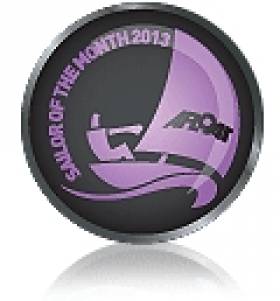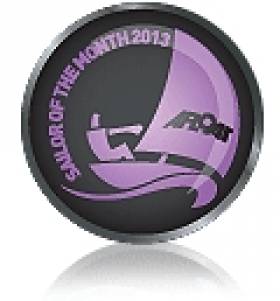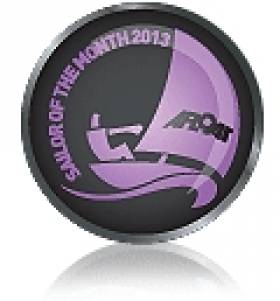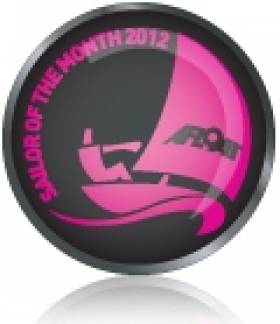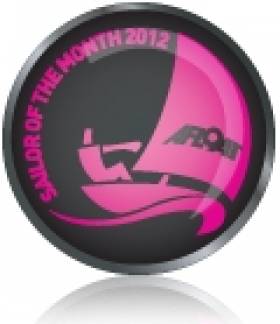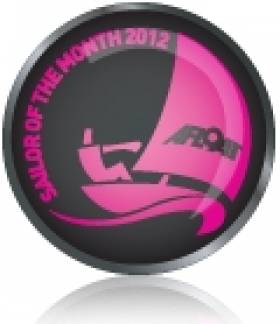Displaying items by tag: Sailor of the Month
The O'Learys of Crosshaven have taken the Sailor of the Month title several times over the years with the remarkable achievements of father Anthony, and sons Peter and Nicholas. But the season of 2013 has clearly demonstrated that there's a new O'Leary on the stage - younger brother Robert, who played a key role in Irish university sailing through March and April.
Previously in the baby brother position as the successful skipper of the family's "cruiserfied" 1720 Antix Beg, young O'Leary is currently making the scene in that hotbed of college development, the University of Limerick. This admired institution's success is doing more to change public perceptions of the sometimes troubled Shannonside city than a whole raft of government inner city initiatives. But even so, when UL came into being in 1989, it would have aroused incredulity to suggest that, by 2013, it would be the clear pace-setter in the highly competitive and long established world of Irish college sailing.
Yet such is the case. And what a pace they've been setting. Despite the coldest Irish spring in years, it was the Limerick college sailors who kicked the new season into action by hosting the three day Intervarsity Team Racing National Opens over the St Patrick's weekend in March. Run in Kerry in conjunction with the hospitable Tralee Bay SC, and sailed in Fireflies, the series attracted 26 teams. The logistical demands were such that Robert O'Leary stayed ashore as overall event manager, but UL was on a roll and they won the main title too, captained by Ross Murray.
Then in April O'Leary was very much afloat, skippering the UL crew in the Student Yachting Worlds Irish selection trials raced over three successive Saturdays in April in the SailFleet J/80s, currently based in Howth. The format was demanding, as it involved getting your crew on site three times over a two week period, and then coping with very different conditions on three separate occasions. But it was an ideal selection method, as the Worlds in France at the end of October – to be sailed in J/80s –will make a considerable demand on resources and organisational ability, so those who could cope with the special challenges of the Howth series are clearly made of the right stuff.
On top of that, with no discards, consistency afloat was vital. The great Robert Scheidt of Brazil, probably world sailing's best-liked superstar, remarked very recently that in the final analysis, modern sailing is a consistency sport. Before he'd said it, the Limerick college sailors showed they were well aware of this reality. On each of the three Saturdays, Rob O'Leary sailed them to a first and second. Three firsts and three seconds is "quite a consistent scoreboard". Coupled with his achievements in March in ensuring the success of the staging of the team racing championship, Robert O'Leary is a very worthy Afloat.ie Sailor of the Month for April 2013.
Sailors of the Month Fergus & Kay Quinlan
#sailorsfofthemonth – Fergus and Kay Quinlan's three year voyage around the world in their own-built 12m steel cutter Pylades has been an inspiration to Ireland's sailing community. And now it has received international acclamation from the premier global voyaging organisation, the Ocean Cruising Club, which has given the County Clare couple – who sail from Kinvara on Galway Bay – the special OCC Award for those "who have done most to foster and encourage ocean cruising in small craft and the practice of seamanship and navigation in all branches".
The magical cruise of the Pylades has already been awarded the Irish Cruising Club's senior trophy, the Faulkner Cup (which dates from 1931), for an unprecedented three years in a row. And for the many in Ireland who have been following the cruise, it comes as no surprise that the experienced adjudicators in the Ocean Cr C have also found the cruise of the Quinlans to be both an informative entertainment, and a realistic encouragement to those who would hope to do something similar.
Realism and the realisation of the ocean voyaging dream were the themes of their achievement. It began prosaically enough. Once they'd decided to do it, Fergus went off and took a welding course so that they could build the boat themselves from scratch. They built her very well – the van de Stadt-designed Pylades looks good, and she has come through everything the oceans of the world could throw at her in a 40,486 mile voyage.

Two sailors ashore, high in the mountains – Fergus and Kay Quinlan in the midst some hill climbing on the island of Reunion in the Indian Ocean.
At the Irish Cruising Club's Annual Dinner in Galway on March 9th, Fergus was the main speaker, and his entertaining musings were purest gold on the enduring attraction of ocean cruising "when we find ourselves on the back of a vast surging ocean entering a dream world, a dream world of boundless horizons. In daylight, we scan the sky for those elusive small white puffy clouds that might indicate the trades. At night, we are transfixed with the shifting rhythms that play on sea and sail, our furrowing of the deep disturbs a billion luminescent swimmers who stream away from our stern in sheets of fading phosphorescence".
Truly inspirational, the cruise of the Pylades has quietly and movingly set a standard to which the rest of us can only aspire.
February Sailors of the Month, Simon & Nancy Pietro
#sailorofthemonth – Simon and Nancy de Pietro of Kinsale Yacht Club are the Afloat.ie Sailors of the Month for February after their convincing win in Class 1 in the RORC Caribbean 600 Race. With strong family links to North Cork and Sligo, they fly the burgee of the popular club on the south coast of Ireland for their successful international sailing programme.
Although their 76ft Philippe Briand-designed Lilla is a much-loved 20-year-old veteran, the high standard of maintenance which is lavished by this enthusiastic sailing couple on their hard-working charter boat shows itself in the consistency of the boat's racing performance in a competitive programme which is fitted around a regular working life on the Caribbean cruise circuit.
The quiet season in the Caribbean is in the summer, and last year saw Lilla avail of summer's opportunity to come north in June and race in the famous biennial Newport-Bermuda Race, which was first sailed in 2006. With Simon as skipper and Nancy as navigator, they won overall in the cruising division. Lilla clearly likes racing to Bermuda, as she has also won overall in another contest to the "onion patch", the annual race from Marion in Massachusetts.
For the start of 2013, Lilla's charter programme was put on hold for a while as she geared up for the new sunshine classic, the RORC Caribbean 600. Although she has relatively shallow draft in order to maximize her cruising choices, she is raced so skillfully that the expected limitations on her windward performance simply don't seem to materialize.

Looking every inch a winner, Lilla comes rocketing out of the start of the Caribbean 600 on Monday February 18th. Photo: RORC/Tim Wright
She came rocketing out of the breezy windward start of the Caribbean 600 off Antigua with a real flourish, and built on success to clinch the Class 1 win and place 8th overall in a very competitive fleet. In a race in which several distinguished competitors dropped out because of weather damage, their result reflects great credit on our new Sailors of the Month.

With sheets slightly eased after weathering Antigua, Lilla starts to power along towards her win. Photo: RORC/Tim Wright
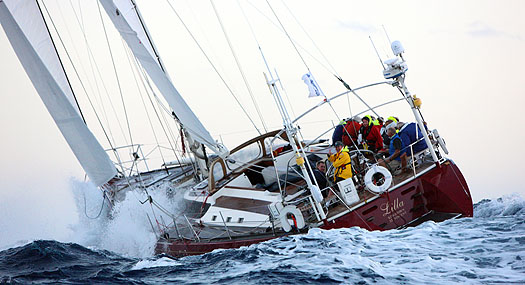
She may be "just a very nice cruising boat", but this is the view most racing competitors get of Lilla. Photo: RORC/Tim Wright
Sailor of the Month December - Brian Craig
#sailorofthemonth – As we look back over the extraordinary mixture of memories stirred up by the Irish sailing season of 2012, one exceptionally good deed stands out in a sometimes slightly wicked world.
Questions were asked about some major events in Ireland and abroad during 2012, while in others, distasteful rows blew up which could have been much more competently handled. But over and above it all, and glowing with increasing strength as the passing of time enhances the recollections, is the happy memory of the Four Star Pizza ISAF Youth Worlds in Dun Laoghaire in July.
With 63 nations involved, it was the most international sailing event ever seen in Ireland. It involved the active input of an army of volunteers ashore, and a navy of volunteers afloat. With so many people taking part at some level or other, the scope for friction – at the very least – was incalcuable.
Yet the ISAF Youth Worlds seemed to effortlessly achieve that true spirit of local, national and international goodwill to which to many comparable events aspire, but not all realize. It made a lasting impact, and was lavishly and deservedly praised by outgoing ISAF President Goran Petersson at the ISAF Conference in November.
Only with a very exceptional administrator and delegator leading an inevitably complex organization can such a satisfactory outcome be achieved. Irish sailing in general, and Dublin Bay in particular, is fortunate in being able to call on the services of Brian Craig to lead the administration in events as demanding as the ISAF Worlds. Not only did he put in the long hours necessary to ensure its smooth running, but long beforehand he gave generously of his time to ensure that Dublin Bay's claim to stage this event was internationally acknowledged and approved. Brian Craig is the Afloat.ie "Sailor of the Month" for December in celebration of his unrivalled contribution to the sailing season of 2012.
Afloat Sailor of the Month November - UCD Sailing Team
#ucd – Never before have we had ten Afloat.ie/Irish Independent "Sailors of the Month" in the one month. But with Christmas approaching it's time for gifting all round, and the adjudicators have agreed the entire UCD team that clinched the Student Yachting Worlds in France four weeks ago are Sailors of the Month for November.
UCD Sailing Club Captain Cathal Leigh-Doyle made best use of the extensive resources of talent available in Ireland's largest university by taking along a squad of ten, even though the boats used are actually raced by eight.
Ever since they won the right to represent Ireland by taking the national college title in Dun Laoghaire in March, the UCD club's key officers had been keeping an intensive training programme on track. They'd also copped on to the significant fact that you're allowed to deploy substitutes, massively important when the high-scoring overnight offshore race followed immediately after a day of intense inshore contests.
With the points table at a crucial phase, sailing skipper Aidan MacLaverty and tactician Barry McCartin were able to bring on board the fresh energy of the highly experienced Ben Fusco and Ellen Cahill for the marathon overnight contest, and this made for the key contribution to the massive points lead with which the Irish team clinched the world title.
The complete team were Cathal Leigh-Doyle, Aidan McLaverty, Barry McCartin, Ben Fusco, Ellen Cahill, Simon Doran, Bella Moorehead, Alyson Rumball, Theo Murphy and David Fitzgerald, and they did us proud.
Afloat Sailor of the Month September - Fionn Lyden
Arise, Schull, and take your place among the great sailing centres of the world. Move over Sydney. Newport stand aside. Cowes make room. The port in West Cork is punching way above its weight, and last weekend it hosted a superb National Junior Championship which saw a local boy as runaway winner against the best that Ireland can produce.
Fionn Lyden (17) is the Afloat.ie/Irish Independent "Sailor of the Month" for September after nine wins in nine races in the Irish Sailing Association Junior All Ireland Sailing Championship, racing in a fleet of 21 of the top helming talents recruited nationwide.
But what we're celebrating here isn't just one special talent, rather it's the entire Schull spirit with a thriving Community College which has sailing and maritime studies at the heart of its curriculum. It's not something which has happened overnight. It has been built up by many dedicated enthusiasts over decades, and today's rich legacy of healthy involvement with boats and sailing invigorates the town and its part of West Cork, an enormous credit to those who have worked away in the background to make it happen, and keep it happening.
These days the leading organisational figure is David Harte. Lucky indeed is Schull, that this was the place this exceptionally talented sailor, teacher and boat builder always called home while he developed his early career at the sharp end of international sailing all over the world.
The racing last weekend under Harte's direction was in the boats of the Schull-developed TR 3.6 class, and as they're sailed two up it could be argued that this gave an advantage to those accustomed to double-handed dinghies. But that's the way it is in sailing, and as the programme of close racing in good condition in a steady easterly unfolded, it was clear that the local duo of Fionn Lyden and school colleague Anna O'Regan were in a league of their own.
Their closest challenger initially was Finn Lynch of the National YC in Dun Laoghaire, winner of the Laser Single-handed Silver Medal at the ISAF Youth Worlds in July (when he was Sailor of the Month). In the end with Lynch being tripped by a tenth in the final race, it was Lydens all the way, as Eoin Lyden made it first and second for Schull, with Lynch third, while Anna Keller of Lough Derg was first girl at 7th overall, Laura Gilmore of Strangford Lough taking second at 9th OA.
Annalise Murphy - Sailor of the Month - August
#sailor of the month – Annalise Murphy of the National YC in Dun Laoghaire is the Irish Afloat.ie/Irish Independent "Sailor of the Month" for August following her outstanding performance in the London Olympics. The talented and dedicated 22-year-old had the entire country in thrall as she battled with the fierce challenge of being top of the Women's Laser Radial class, and her fourth place overall, shy of a medal by fractions of a second, is the best Irish Olympic Sailing Result for thirty years.
Merely to describe her result as fourth overall fails completely to capture the essence of Murphy's performance. For about half of the regatta, she was in the Gold Medal slot. Then having slipped down to bronze rankings, she regained the top place with only one race to sail.
At this level of sailing, being top leaves a helm open to all sorts of joint challenges by those nearest in rankings. Like it or not, this is the way it is in sailing. Because there are ten boats involved, and with the wind being the motive power, the opportunities to block off a clear breeze or create other distractions for those heading the points table are there for the taking. When a leader is slowed back by one boat, two or three others can climb up the rankings at the previous leader's expense.
With four of the world's top women sailors in contention for the Gold going into that final race, the pressure was unbelievable. And with the race being staged in the fluky breezes close in off the Nothe at Weymouth, tiny gains could suddenly become significant gaps through vagaries of the wind.
It tells us everything about the stratospheric level of sailing in the Olympics that despite conditions which would have seen club racers spread over a wide time band, the Women's Laser Radials were finishing in tight order. But within that order, it was the Irish girl who - after leading for most of the series - lost out in the final leg.
But despite the outcome, throughout Ireland - maybe for the first time - people fully appreciated what is involved. Through her achievements and popular appeal, Annalise Murphy did more to raise the profile of our sport than any other Irish sailor in this extraordinary year, or indeed for many years.
Irish Sailor of the Month 1996 - 2008
Born in 1996 to salute the achievements of Irish sailing stars the Afloat Sailor of the month awards nearly pre-date the internet!
From 2009 the monthly and annual awards are documented online here but for the moment the record of monthly award winners for 12 years from 1996 to 2008 are preserved only in print. They're proudly named in the back issues of Afloat magazine, Ireland's boating publication.
We are working towards publishing these years online too. Watch this space for our full roll of honour from 1996 onwards. Thanks for your interest!
Gordon Maguire is January's Sailor of the Month
#sailorofthemonth – As we move into 2013 with The Gathering gaining strength, and the prospect of an Irish Diaspora Centre in Dun Laoghaire Harbour becoming a realistic prospect, it's appropriate that the first Afloat.ie "Sailor of the Month" in 2013 should be Gordon Maguire. He has successfully carried the best reputation of Irish sailing to every corner of the world, but although now based in Australia, he maintains strong links with home, with his many successes shared by Ireland's maritime community.
In the first week of January 2013, Gordon Maguire celebrated 53 straight weeks of exceptional achievement. The 63ft Reichel Pugh sloop Loki, aboard which he is sailing master, had been confirmed as overall champion in the Australian Blue Water Points Score. This has to be the ultimate test of offshore racing enthusiasm and dedication, as it's a seven race season-long series with no discards, culminating in the Sydney-Hobart Race.
While defending champion Loki may have had to concede the Hobart race win this time round to the 100ft Wild Oats XI, she was a very solid second, and well ahead of her nearest challenger in the Blue Water Series. As for conceding that one win to Wild Oats, it was the only time throughout the series that Loki had done so. In the second-longest race, the 384-mile Sydney to Gold Coast Race, Loki had been on top form for a convincing overall win. And of course her successful progress through the season of 2012 had been launched with her stunning victory in the tactically-demanding December 2011 Sydney-Hobart Race.
Gordon Maguire's four years of growing success with a mixed amateur-professional crew aboard Stephen Ainsworth's Loki speaks volumes for his exceptional talents as a helmsman, his inspiring ability as a leader, and his high qualities as a team member. Added to his record as a champion round the world racer and a winner in many other events, it is the latest chapter in a remarkable success story for Irish sailing.
Afloat/Irish Independent Sailor of the Month
Created in 1996, the Afloat Sailor of the Year Awards represent all that is praiseworthy, innovative and groundbreaking in the Irish sailing scene.
This is a national award especially designed to salute the achievements of Ireland's sailing's elite.
Over nearly two decades the awards has developed in to a premier awards ceremony for water sports.
Since it began 17 years ago the awards have recognised over 200 monthly award winners in the pages of Ireland's sailing magazine Afloat and these have been made to both amateur and professional sailors.
The first ever sailor of the year was Dinghy sailor Mark Lyttle.
Now proudly in its 18th year we've already recognised sailors, ex-pat gordon Maguire from Howth for for his dramatic win in January's Sydney-Hobart race became the first monthly winner in 2013 and the account of his exploits are on this website.
As a sport we often grumble that sailing doesn't get the recognition it deserves but through these awards and the support of our sponsors past and present there is a bigger chance of presenting the remarkable achievements of Irish sailors that all too often do not get the media coverage that we all think they deserve.
An online readers poll plus a vote from a panel of sailing journalists and administrators select the annual winner.


























